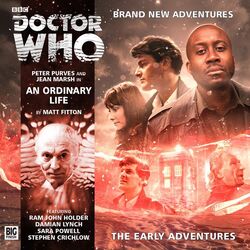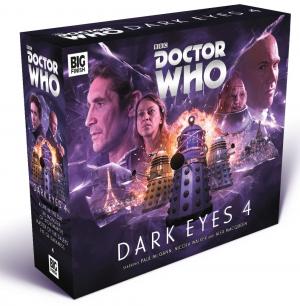New Adventures With The Eleventh Doctor #9 - The Rise And Fall
Writer Al Ewing, Artist Boo Cook,
Designer Rob Farmer, Colorist Hi-fi,
Letterer Richard Starkings And Comicraft’s Jimmy Betancourt,
Editor Andrew James,,
Assistant Editor Kirsten Murray
Released - March 2015
The employees and big wigs of SERVEYOUInc turn up to work expecting just another day at the office, on a world which would more accurately fit the description of an asteroid - except it is full of light, colour. A true embodiment of pizzazz. But individuality and creativity are looking like they might die out.
The sleeping giant that had briefly reared its head in the science labs is loose and the entire playing board where the Doctor is involved has been reset. This malevolent entity is making a play for power, and the surrounding inhabitants that were utterly dependent on the galactic corporation can only react passively to this dark turn of events
And what of the TARDIS crew who have been going back and forth through time and space with grave fear that they are being stalked? And after the near Armageddon in the Solar System during their last adventure, can they expect any respite that common decency demands?
The answer is simple: No, and there are more trials and tribulations coming en masse.
But the Doctor won't react cagily like some. This time enough really is enough. Spurred on by the disturbing manipulation of Alice by the very-much-'alive' Talent Scout, the Doctor is taking the fight to SERVEYOUInc. Or whatever he finds down on the asteroid...
This latest instalment in the 11th Doctor range builds on the arc that has been so strong and noticeable up to now, (excepting the chronic instabilities of High-Watermark-Issue 6).
Red herrings have been scattered in the readers direction leading up to this latest edition, and it is very organically done when the reader is alerted to who the real enemy is for the Doctor and friends. The final pages and panels are especially riveting as the TARDIS crew have a seeming traitor in the midst, when that would be the last thing they would have come to expect by now.
After Warren Pleece's somewhat inconsistent efforts in the previous two issues, we are once again privy to the assured work of Boo Cook. This type of presentation is once again more than ideal - for my money anyway - and really sells the emotional stakes very well. The sheer fury that the Doctor is trying to stop from erupting is never far away, even when he contrives to make light of the events and people he encounters.
The duo of ARC and Jones however continue to serve the plot first and foremost. They really have lacked the splendid rich character development of Alice, but perhaps there is a planned pay-off which still requires perseverance for these two unique individuals.
The dialogue is full of great moments. A few select gems of our leading rogue Gallifreyan being:
"I’ve made my calls and I’ve done my homework and today this day is the day it comes down. Today......I mean business".
"I’ve spent a thousand years living in a box and stealing most of my clothes. I’ve saved up" (when the Doctor is challenged over finances).
And the dismissive " Whatever they've done, they’re just... monsters. That's all. Because they don’t have the imagination not to be monsters. They can’t think of any other way than cruel and cowardly".
Al Ewing has been a touch questionable in his consistency compared to colleague Rob WIlliams, but this issue is very strong work and now has convinced me that his earlier plotting choices were well-chosen and will pay off well.
This is an assured and swift read for any true fans of Matt Smith's era, and hopefully Doctor Who fans in general. I never felt like I was having to generate belief in the story, and I managed it in one sitting being left wanting more. And with such a brilliant cliff-hanger to tantalise, 'more' is certainly coming with the force of a speeding bullet.
Bonus Humour 'Tag' Stories:
'Daylight Savings' is a perfectly respectable piece of fun from regular writer and 3D artist AJ. As the clocks move forward at the time of reviewing this issue, it is amusing to see the Doctor have his own issues with units that measure time. And some old 'friends' that were brought to life from Steven Moffat's vast imagination on several occasions make a suitably mechanical impression.
Marc Ellerby conveys a brilliant return to the much-loved quartet of Amy, Rory, The Doctor and River with 'Double Date'. The near-absurdities of age gaps and power relations not being as they should are brilliantly high-lighted with sharp banter and a dollop of awkwardness. The variety of colours for backgrounds help the 2-d sketches feel as lively as AJ's computer wizardry.









